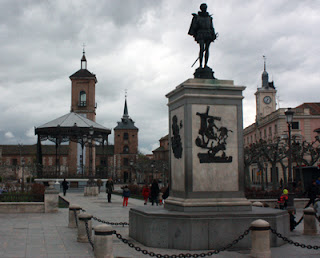If you do not know
Tapas, then you do not know Alcalá or its inhabitants. Going out for Tapas in
Alcalá is much more than gastronomy, it is a social action.
Alcalá de Henares’ gastronomy is
famous due to its traditional dishes and its classical confectionery. But not
everything is tradition in Alcalá nowadays, the city is alive and dynamic city
and its inhabitants fancy to live every moment surrounded by his friends and
family.
This
street culture is perfectly reflected in one of the most famous and popular
events that Alcalá’s population daily carries out en masse: Ir de tapas
(to go out for tapas).
What does “Ir de
tapas” means?
If
you do not know Tapas in Alcalá, then you do not know Alcalá or its
inhabitants. Ir de tapas in Alcalá is much more than gastronomy, it is a
social action, a proper life style.
It
just takes to go to some of the many city’s bars and restaurants to taste “a
Tapa” in company. A Tapa is not more than a little portion of food served
with some drink (with or without alcohol), though the most frequent combination
is to take it with a beer. The concept is simple, but leads to one of the most
important social action of our culture. In our region, it is quite an affair
regularly practiced, as frequently as possible: going out from work, Sunday
mornings, Friday nights, any festivity… any occasion at all is good to go out
in good company to eat some Tapas .
If
weather allows and the company is pleasant, Ir de tapas is
frequently called Ir de Tapeo (to go out for Tapeo). Basically,
it means that you repeat the ritual time and again in different bars of the
same area. It is ideal to spend a Saturday evening or Sunday midday, and it can
be a good alternative to traditional food.
Curiosity
In
many places of Spain, especially in Madrid, it is common to find bars and
cafeterias where free food, like olives or chips—the two most typical sides—,
are offered with the drinks you order. However, in Alcalá, the concept of Tapa
is much more important, as taking one or two drinks with its sides is
equivalent to take a light meal.
http://i2.wp.com/www.dream-alcala.com/wp-content/uploads/2013/06/TapaClasica.jpgThe
etymological origin of the word “Tapa” comes from the old costume of
taverns and inns, of covering wine glasses with a portion of bread—with or
without a ham slice—in order to avoid flies or mosquitos to get into the glass
or to prevent dust to fall inside. Fortunately, the situation has changed…
Nowadays,
Tapas are authentic expressions of creativity, small and exquisite
bites. In several occasions, the Tapa upstages the drink itself, so it is not a
side anymore, but the real star.
Tapas have come
to be a true Spanish identity sign and are offered in reception feasts for the
highest dignitaries (in the so-called Tapas meeting).
How a tapas bar is
supposed to be?
Find
a real Tapas bar in Alcalá in the first video showed here (upper right
corner). In general terms, it is a nice and casual place, highly informal, as
the main aim of that place is to get is to have a nice chat while sharing
experiences with your friends. In many of them, you may see an exposition of
selected Tapas for you to taste on the counter. In some places you can
choose the Tapa you want to eat from a selection list. In others—with
lower prices—the waiter simply gives you a standard Tapa chosen by him
and served with your drink.
Following,
several kinds of Tapas can be appreciated in the Gallery. There are
countless types, from the simplest ones to the most refined. Many of them are
for free while others, you have to pay for them separately.
Notwithstanding,
all of them will achieve that you have a nice time in an animated environment.
Recommended places
to go out for Tapas in Alcalá:


















